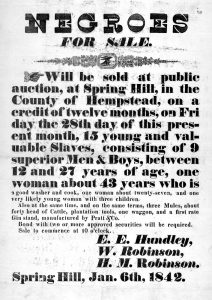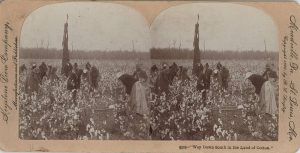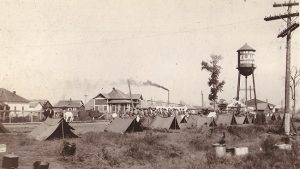calsfoundation@cals.org
Via Negativa
You may have noticed that Arkansas was in the national news a few weeks ago. This is rarely a good thing.
In this particular case, the national ire and incredulity directed toward the Natural State related to two bills, House Bill 1218 and House Bill 1231, which would have prohibited schools from offering any curriculum that might broadly promote the idea of social justice and prohibited schools from using any curriculum linked to the New York Times’s 1619 Project, respectively.
 The latter bill, in particular, attracted a great deal of attention, given that the 1619 Project has been the object of extensive celebration and debate since its release in 2019, the 400th anniversary of the arrival of African slaves in the American colonies. Broadly speaking, the aim of the project is to center the experience and institution of slavery in American life; to demonstrate the full reality of slavery’s imbrication in the culture, economy, and politics of the United States; and to illustrate the continuation of this antebellum project of racialized exploitation and oppression well into the twenty-first century. In fact, the authors of the 1619 Project go so far as to state that the primary motivation underlying the Revolutionary War was the desire of the colonists to preserve the institution of slavery.
The latter bill, in particular, attracted a great deal of attention, given that the 1619 Project has been the object of extensive celebration and debate since its release in 2019, the 400th anniversary of the arrival of African slaves in the American colonies. Broadly speaking, the aim of the project is to center the experience and institution of slavery in American life; to demonstrate the full reality of slavery’s imbrication in the culture, economy, and politics of the United States; and to illustrate the continuation of this antebellum project of racialized exploitation and oppression well into the twenty-first century. In fact, the authors of the 1619 Project go so far as to state that the primary motivation underlying the Revolutionary War was the desire of the colonists to preserve the institution of slavery.
This was a bridge too far for some. Five historians—a group that included such stalwarts of their fields as James McPherson, Gordon Wood, Victoria Bynum, Sean Wilentz, and James Oakes—circulated a letter describing the 1619 Project as “a displacement of historical understanding by ideology” even as they praised it for addressing “the enduring centrality of slavery and racism to our history.” As Adam Serwer writes in The Atlantic: “The clash between the Times authors and their historian critics represents a fundamental disagreement over the trajectory of American society. Was America founded as a slavocracy, and are current racial inequities the natural outgrowth of that? Or was America conceived in liberty, a nation haltingly redeeming itself through its founding principles? These are not simple questions to answer, because the nation’s pro-slavery and anti-slavery tendencies are so closely intertwined.”
Granted, some people have aimed for simple answers to these questions. For example, President Donald Trump authorized the creation of the 1776 Commission for purposes of regurgitating the grade-school narrative of unquestioned American greatness unto the nation. And, as noted above, some in the Arkansas legislature tried to prohibit the use of 1619 Project materials in state classrooms. (Arkansas is not alone in this—such a bill also showed up in Iowa.)

Outside of Native American groups, for whom America’s independence and expansion most often meant their dispossession and extermination, many of us in this country have long regarded the first shots fired in opposition to British rule as at least the imperfect beginning of an imperfect nation’s slow but sure march toward some semblance of progress. Martin Luther King Jr.’s famous “I Have a Dream” speech echoes how African Americans had long embraced the idea of a constitutionalist vision that could expand to include them: “When the architects of our republic wrote the magnificent words of the Constitution and the Declaration of Independence, they were signing a promissory note to which every American was to fall heir. This note was a promise that all men—yes, black men as well as white men—would be guaranteed the unalienable rights of life, liberty and the pursuit of happiness.” And so the 1619 Project’s insistence that those shots were fired to maintain slavery, and its further claim that most evidence of any progress since then has been largely illusory, can work against our sense of collective identity, as well as reflect a cynicism that seems undercut in part by the publication and popularity of the 1619 Project itself.
The truth is that our collective self cannot really be encompassed by any ideological framework. The subject’s complexity requires that we approach it in a more philosophical sense, much in the same way that Platonic and later Christian thinkers tried to approach the nature of the divine. First, one can approach the divine by means of cataphatic (positive) theology, which uses positive affirmations such as “God exists.” There is also the apophatic (negative) approach that attempts to derive deeper meanings from negative statements. For example, a statement such as “God does not exist,” in the context of this strain of Christian theology, is not an atheistic assertion but the opportunity to dwell on the deeper meaning of existence and to assert that God does not, in fact, exist in the same way that human beings or chunks of quartz do, limited by the dimensions of time and space.
Let us take this approach to our history. “America was founded on the principle of freedom.” This is true: the idea of life, liberty, and the pursuit of happiness is not simply an empty vessel aboard which one can smuggle a justification for enslavement. These are words that have inspired revolts against tyranny all over the world, even revolts against American slavery itself. “America was founded to protect the institution of slavery.” This is also true. Enlightenment ideals of freedom often centered upon a freedom of property that was vitally important to an emerging middle class existing within monarchial systems where the royal appropriation of property was a significant threat. And, as it happens, in the American colonies, one of the chief forms of property, by total value, was the mass of men and women held in slavery.
Both of these statements are true, and they are true without negating one another. The second claim, in many ways, operates as a subset of the first, given how freedom was defined at the time.
***

In a recent presentation for the Central Arkansas Library System’s Black History Month commemoration, historian Richard Buckelew of Bethune-Cookman University observed that, while Arkansas recorded some 375 lynchings between 1836 and 1936, there were also 223 threatened lynchings that were prevented. As Buckelew noted, this information could be read two different ways. First, if you add the numbers together, you get a better picture of the total violence against marginalized people in the state, especially African Americans, given that such public threats against the lives of prisoners served as a means of terrorizing groups in much the same way that completed lynchings did. However, one can also look at these numbers and appreciate the level of active resistance, on the part of law enforcement and the general public, to the practice of lynching. This does not mean that justice was the rule in Arkansas; for black men accused of crimes, our normally operating system of law and order (especially as exemplified by such laws as Act 258 of 1909) could be just as deadly as the mob armed with rope and rifles. But it does challenge the stereotypes of sheriffs and police chiefs being uniformly complicit with mob violence.
 In that, we can begin to apprehend some of the complexity in the lives of those touched by racial violence. Some years back, I corresponded with a man who had come to a potential realization about the unspoken history of his own grandfather. He had heard from family members that his grandfather had been part of some posse and had participated in some acts that later filled him with regret and shame. In the community, he attracted particular attention for his willingness to aid local African Americans financially, and it was said that he did this from a great sense of guilt. But no one ever told our correspondent what his grandfather actually did, and he remained oblivious but curious until a little digging led him to our entry in the CALS Encyclopedia of Arkansas on the St. Charles Lynching of 1904. This matched all the clues he had gathered over the years, and he wanted to share the story with us.
In that, we can begin to apprehend some of the complexity in the lives of those touched by racial violence. Some years back, I corresponded with a man who had come to a potential realization about the unspoken history of his own grandfather. He had heard from family members that his grandfather had been part of some posse and had participated in some acts that later filled him with regret and shame. In the community, he attracted particular attention for his willingness to aid local African Americans financially, and it was said that he did this from a great sense of guilt. But no one ever told our correspondent what his grandfather actually did, and he remained oblivious but curious until a little digging led him to our entry in the CALS Encyclopedia of Arkansas on the St. Charles Lynching of 1904. This matched all the clues he had gathered over the years, and he wanted to share the story with us.

Other descendants on both sides of racial atrocities have reached out to us through the years, sending us, for example, photographs relating to the Elaine Massacre or the lynching of Ed Coy, or thanking us for providing information about ancestors who were lynched more than a century ago. And as people share their knowledge with us, and we make it available to the world, we collectively build a bigger picture of our world, of our history, of our shared heritage as Arkansans and Americans. That picture is bigger than the simplified assertions of America’s unique greatness or badness, bigger than base claims that tend to eternalize the figures at the center of every conflict into roles either heroic or villainous.
Yes, the state of Arkansas has attempted to prohibit classroom discussion of anything that might besmirch the nobility of our ancestors. However, the state of Arkansas has also done more than many others to acknowledge the historical horrors that occurred on its soil. Or as Herman Hesse wrote in Siddhartha, “The opposite of every true thing is also true.”
By Guy Lancaster, editor of the CALS Encyclopedia of Arkansas




